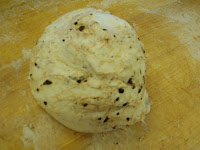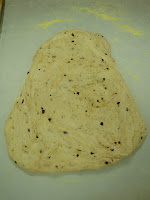Day 12, Tuesday
11.18.2008
Baguette and Fougasse
The Baguette dough we made in bulk and the Fougasse dough we made by hand. We were using the Straight Dough Method- S.D.M. The Desired Dough Temperature is the DDT. You can control the temperature of the water. The Friction Factor is associated with the friction created by the mixer paddles. You can calculate the heat generated by the mixer.
The baguette recipe is in pounds and ounces so we need to convert it to baker’s percentage.
170 oz water 70.83%
5 oz yeast 2.08%
15 lbs bread flour 100%
5 oz salt 2.08%
Each baguette is 13 oz, 21”-22” long, with 5 slashes across the top
Each person will make two baguettes at 13 oz, 13 X 2= 26 oz dough per person
26 oz X 25 students= 650 oz dough total
15 lbs= 240 oz 100%
170/240= .7083 70.8%
5/240= .0208 2%
5/240= .0208 2%
175%
The yeast is proportioned to the speed of proofing. The yeast smells bad so you don’t want to increase it too much in your dough.
650/ 175%= 3.71 Conversion Factor
370 oz bread flour
262.8 oz water
7.72 oz yeast
7.72 oz salt
We iced the water to control the temperature of the dough.
DDT- 75˚ X 3= 225˚
Flour temp- 72˚
Room temp- 77˚
Friction Factor- 28˚- 30˚
75˚ is the optimum temperature. 72˚- 78˚ are good temperatures. The lower the temperature the longer it takes to ferment, the higher the temperature the faster the dough will take to ferment. Sometimes the gluten takes longer to develop; the friction factor in this case is higher. 2˚-3˚ raise per minute of mixing; the dough will mix for around 10 minutes.
225-177= 48˚ water temp
If mixing by hand use hot water because not much friction is involved. The water and ice are the same weight.
Using the Straight Dough Method- everything goes in at once, allow it to ferment in bulk, shape, and then bake. It is a plain dough; there is no time to develop the flavors. It will stale really fast and has no complexity.
The fresh yeast is crumbly. Crumble the yeast before adding it to the mixer. Sprinkle it on one side in the mixing bowl. Start on stir speed. The times are important. Stir on speed 1 for 3 minutes until it comes together.
On speed 2 the gluten develops. Add at least 70-80% of the water in the first stage, less globs will form and the water will be better absorbed. Add more or less water depending on the consistency of the dough. If it is humid you should add less water. If there are a few ice cubes in the water that is ok. The dough will look really tacky, lumpy, and wet. All the flour is picked up off the sides and bottom but it is still lumpy. Add the rest of the water; any ice cubes will melt because of the friction. The second addition of water takes longer to absorb. At the 3 minute point check the temperature, ours was at 55˚. Move it up to a speed 2 for 6 minutes. Drizzle, don’t pour, the salt into the mixing dough.
The more the dough is kneaded the more oxygen is added; the oxygen has a bleaching effect and the bread will be paler in color. Autolyse is when you take the flour and water and let it sit around half an hour then add everything else. This lets the starch absorb the moisture, reducing the mixing times, gives a nice color, and conditions the dough. Our dough is less sticky but not a white color yet. The window pane test can be done by stretching the dough so that you can see through it. It is important to see the colors, consistency, feel it, and hear the dough slapping on the sides of the bowl. We let it mix another 3 minutes.
Baguettes have no oil or sugar; it is pure lean dough. You can add some malt or wheat germ to give flavor. Cover the dough with a plastic bag and let it ferment 1 hour. The gluten develops and relaxes. If it doesn’t ferment enough it is too unstable and when in the oven it will collapse. The dough is not sticking to the hand, is stretching better, and can form the window pane. The temperature is 70˚. It is better to be on the colder side than the warmer side. It will take a little longer than 1 hour, maybe 1 hour 20 minutes to come up to temperature. Cover and leave at room temperature.
Fougasse
17 oz water
½ oz fresh yeast
1 ½ lb bread flour
½ oz salt
1 ½ oz olives
Keep the salt separate. Pour the cold water into the flour. Mix them together. Add the yeast and knead the dough a little.
Take the dough from the bowl and work it on the bench. Stretch the dough and pull it back onto itself, giving a ¼ turn each time. The dough is fairly sticky. The yeast will dissolve easily because it is fresh. Make sure the yeast is dissolved before adding the salt. It should take 15 minutes to do the whole process. Sprinkle the salt in the dough.
Don’t flour the surface at all. You can feel the gluten developing and the dough is not as sticky. You are stretching the gluten and the dough begins to look smoother. Add the olives when the dough feels elastic.
Fougasse is traditional leaf shaped bread. Give it a final rounding or stretching and roll it into a ball with a smooth top. Sprinkle a little flour on the table, put the dough ball down, and cover it with plastic; this is bulk/ bench fermentation.
Fougasse Dough Shaping
You want a wide rectangle. It is a bread made for a community and is shaped like a leaf. Sprinkle cornmeal on parchment paper otherwise the dough will stick. Form the dough into a leaf shape with a wide base and a pointier top and let it proof for around 30 minutes. After proofing use your dough cutter to cut the “veins” of the leaf and gently spread the dough apart at the slits.
You want a wide rectangle. It is a bread made for a community and is shaped like a leaf. Sprinkle cornmeal on parchment paper otherwise the dough will stick. Form the dough into a leaf shape with a wide base and a pointier top and let it proof for around 30 minutes. After proofing use your dough cutter to cut the “veins” of the leaf and gently spread the dough apart at the slits.
Fougasse in oven
We bake the Fougasse at 500˚ in the convection oven on parchment paper on an overturned sheet tray for around 30 minutes.
We bake the Fougasse at 500˚ in the convection oven on parchment paper on an overturned sheet tray for around 30 minutes.
Fougasse Finished
In ripping off a piece you notice the regular crumb except for a few large holes. It has no change in flavor.
In ripping off a piece you notice the regular crumb except for a few large holes. It has no change in flavor.
Baguette dough after resting
Forming the Baguette
Break up the large dough into 13 oz portions, each person will get 2 portions. Dust the surface with bread flour and form it into a rectangle; this is the pre-shaping of the dough.
Break up the large dough into 13 oz portions, each person will get 2 portions. Dust the surface with bread flour and form it into a rectangle; this is the pre-shaping of the dough.
Shaping the doughThe dough looks really relaxed. Have a very tiny amount of flour on your hands and flatten out the dough. You want a nice tight surface to work with. Get rid of the excess air bubbles. Stretch it out and fold it into a rectangle. Fold it over itself and the ends roll out using your palms. As it rolls begins to shrink.
The canvas resting area for the baguettes is called the Couche. You are looking for even, tapered edges, and a rustic look. You want it around 21”. The seam that runs through the baguette should be on the bottom so it doesn’t open in the oven.
Move the canvas to support the shape. Cover with the canvas top and let it proof around 1 hour.
Baguettes are Rested
Want nice round slashes using the lamé, a curved blade used to slice top of the baguettes.
Baguettes in oven
They bake at 550˚ in the deck ovens. Slide baguettes from board directly onto oven stones. Oven spring is the initial build up that takes place within the first 5 minutes in the oven. Turn the steam on; it will settle on the dough and partially gelatinize the crust.
They bake at 550˚ in the deck ovens. Slide baguettes from board directly onto oven stones. Oven spring is the initial build up that takes place within the first 5 minutes in the oven. Turn the steam on; it will settle on the dough and partially gelatinize the crust.
Baguettes Finished
Nice even color with a nice crunchy crust. The steam from the oven and lean dough give it a nice shine. It should have an even shape with out sharp edges. The bread should be cool before cutting. When cut in half, the crumb inside should have Alvioli. These are the even regular gas bubbles that are trapped in the bread. Break a piece and smell it. Smell contributes to the flavor; it smells sweet because it is not fermented. In tasting, it has a little bite to it because of the gluten content and the crust tastes caramelized.




































No comments:
Post a Comment